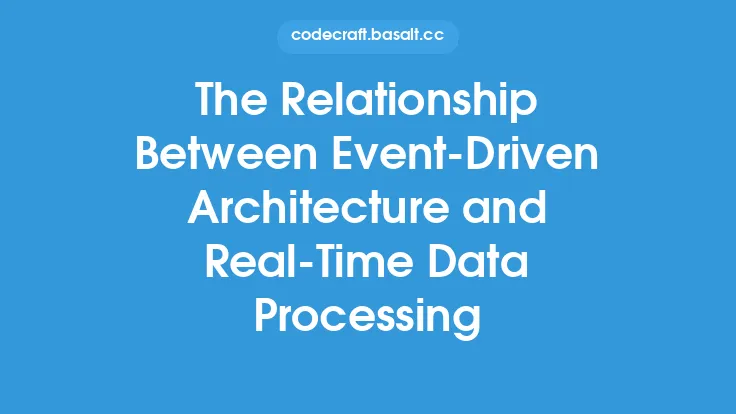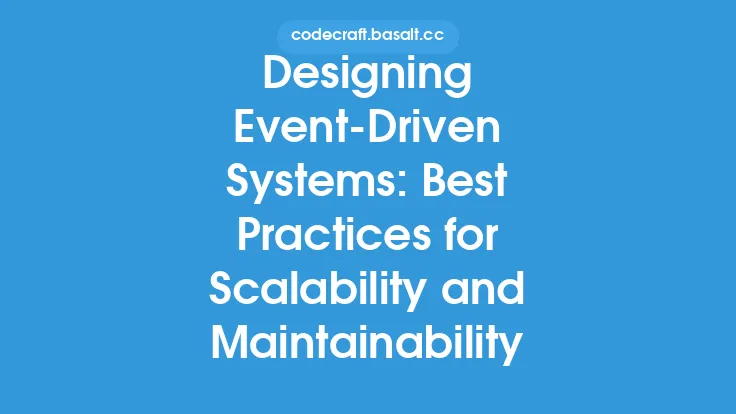Event sourcing and CQRS (Command Query Responsibility Segregation) are two patterns that have gained significant attention in recent years, particularly in the context of event-driven programming. These patterns provide a unique approach to data management, allowing developers to create scalable, maintainable, and flexible systems. In this article, we will delve into the details of event sourcing and CQRS, exploring their principles, benefits, and implementation strategies.
Introduction to Event Sourcing
Event sourcing is a pattern that involves storing the history of an application's state as a sequence of events. Instead of storing the current state of the application, event sourcing stores the events that led to the current state. This approach provides a number of benefits, including the ability to reconstruct the application's state at any point in time, auditability, and improved scalability. Event sourcing is often used in conjunction with CQRS, as it provides a natural fit for the command and query aspects of the pattern.
Command Query Responsibility Segregation (CQRS)
CQRS is a pattern that segregates the responsibilities of handling commands and queries. Commands are used to modify the state of the application, while queries are used to retrieve the current state. By separating these responsibilities, CQRS allows developers to optimize the command and query paths independently, leading to improved performance and scalability. CQRS is often used in conjunction with event sourcing, as it provides a natural fit for the command and query aspects of the pattern.
Benefits of Event Sourcing and CQRS
The combination of event sourcing and CQRS provides a number of benefits, including:
- Improved scalability: By storing the history of events, event sourcing allows developers to scale the application more easily, as the current state can be reconstructed from the event history.
- Auditability: Event sourcing provides a complete history of all changes made to the application, allowing for auditing and debugging.
- Flexibility: CQRS allows developers to optimize the command and query paths independently, leading to improved performance and flexibility.
- Simplified error handling: Event sourcing provides a natural fit for error handling, as the application's state can be rolled back to a previous point in time.
Implementing Event Sourcing and CQRS
Implementing event sourcing and CQRS requires a number of components, including:
- Event store: The event store is responsible for storing the history of events. This can be implemented using a variety of technologies, including relational databases, NoSQL databases, and file systems.
- Command handlers: Command handlers are responsible for handling commands and generating events. These handlers should be designed to be idempotent, meaning that they can be safely retried in the event of a failure.
- Query handlers: Query handlers are responsible for handling queries and retrieving the current state of the application. These handlers should be designed to be optimized for performance, as they will be handling a high volume of queries.
- Event handlers: Event handlers are responsible for handling events and updating the application's state. These handlers should be designed to be idempotent, meaning that they can be safely retried in the event of a failure.
Event Sourcing and CQRS in Practice
Event sourcing and CQRS are being used in a variety of applications, including:
- Financial systems: Event sourcing and CQRS are well-suited for financial systems, where auditability and scalability are critical.
- E-commerce systems: Event sourcing and CQRS can be used to improve the scalability and performance of e-commerce systems, particularly in the context of high-volume transactions.
- Real-time analytics: Event sourcing and CQRS can be used to provide real-time analytics, particularly in the context of IoT devices and sensor data.
Challenges and Considerations
While event sourcing and CQRS provide a number of benefits, there are also several challenges and considerations to be aware of, including:
- Complexity: Event sourcing and CQRS can add complexity to an application, particularly in the context of event handling and command processing.
- Performance: Event sourcing and CQRS can impact performance, particularly in the context of high-volume transactions.
- Data consistency: Event sourcing and CQRS require careful consideration of data consistency, particularly in the context of distributed systems.
Conclusion
Event sourcing and CQRS provide a powerful approach to data management, allowing developers to create scalable, maintainable, and flexible systems. By understanding the principles and benefits of these patterns, developers can create systems that are well-suited to the demands of modern applications. While there are challenges and considerations to be aware of, the benefits of event sourcing and CQRS make them a compelling choice for developers looking to create robust and scalable systems.





